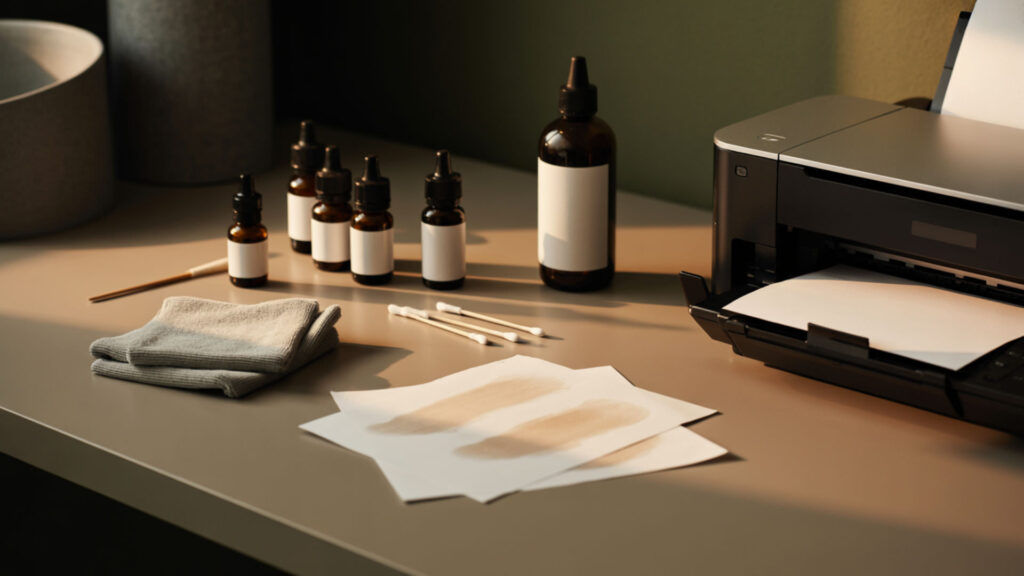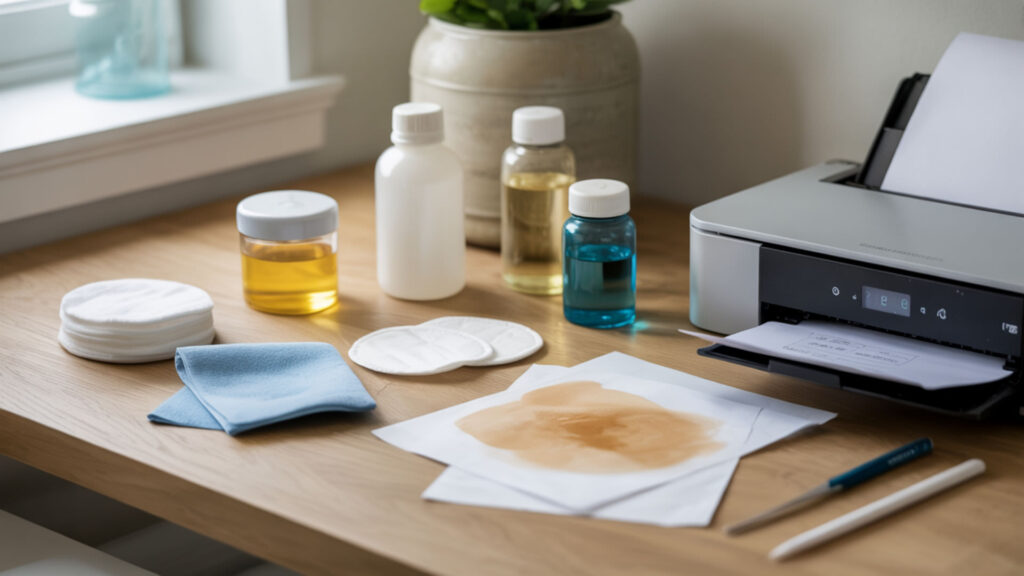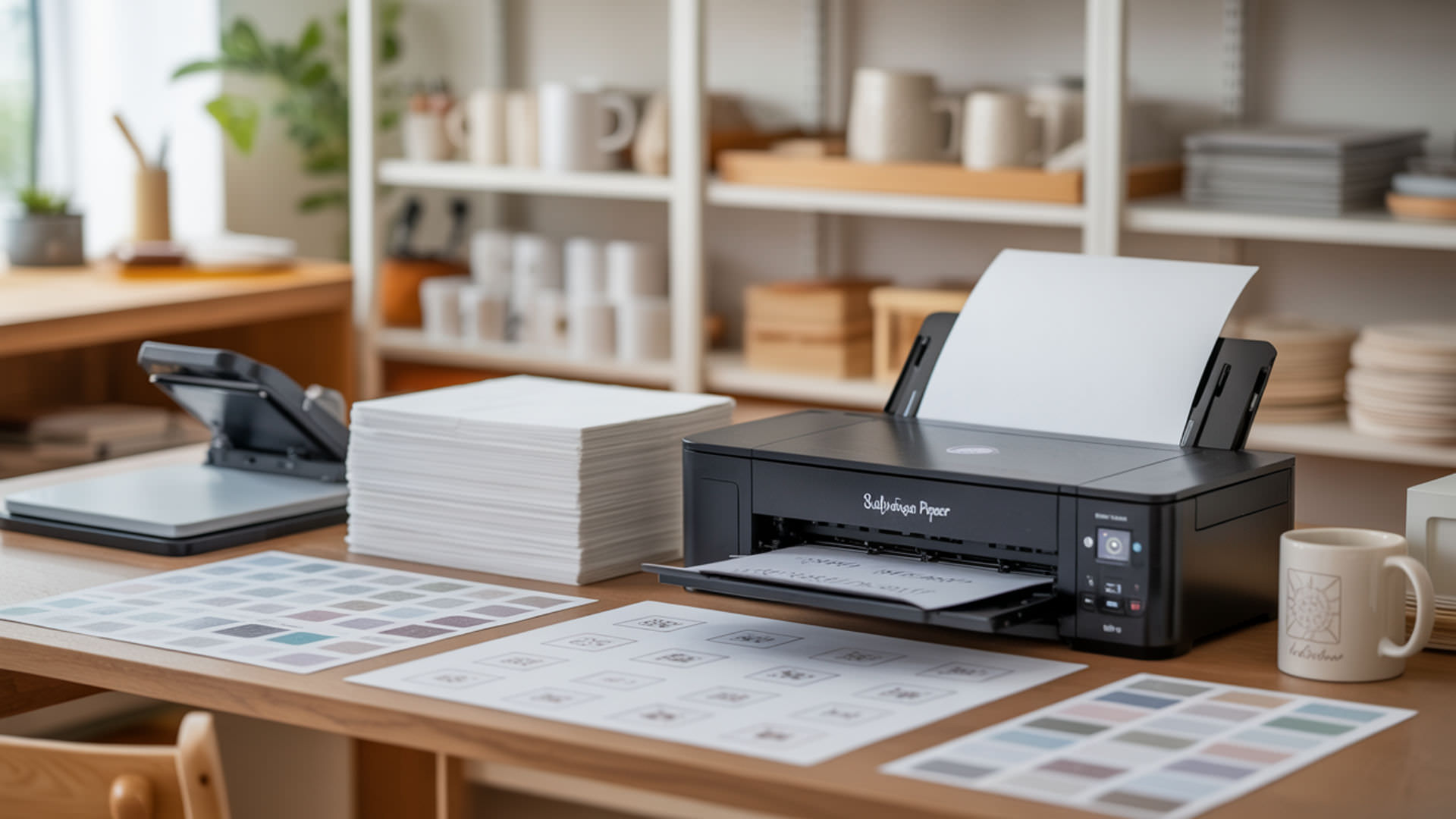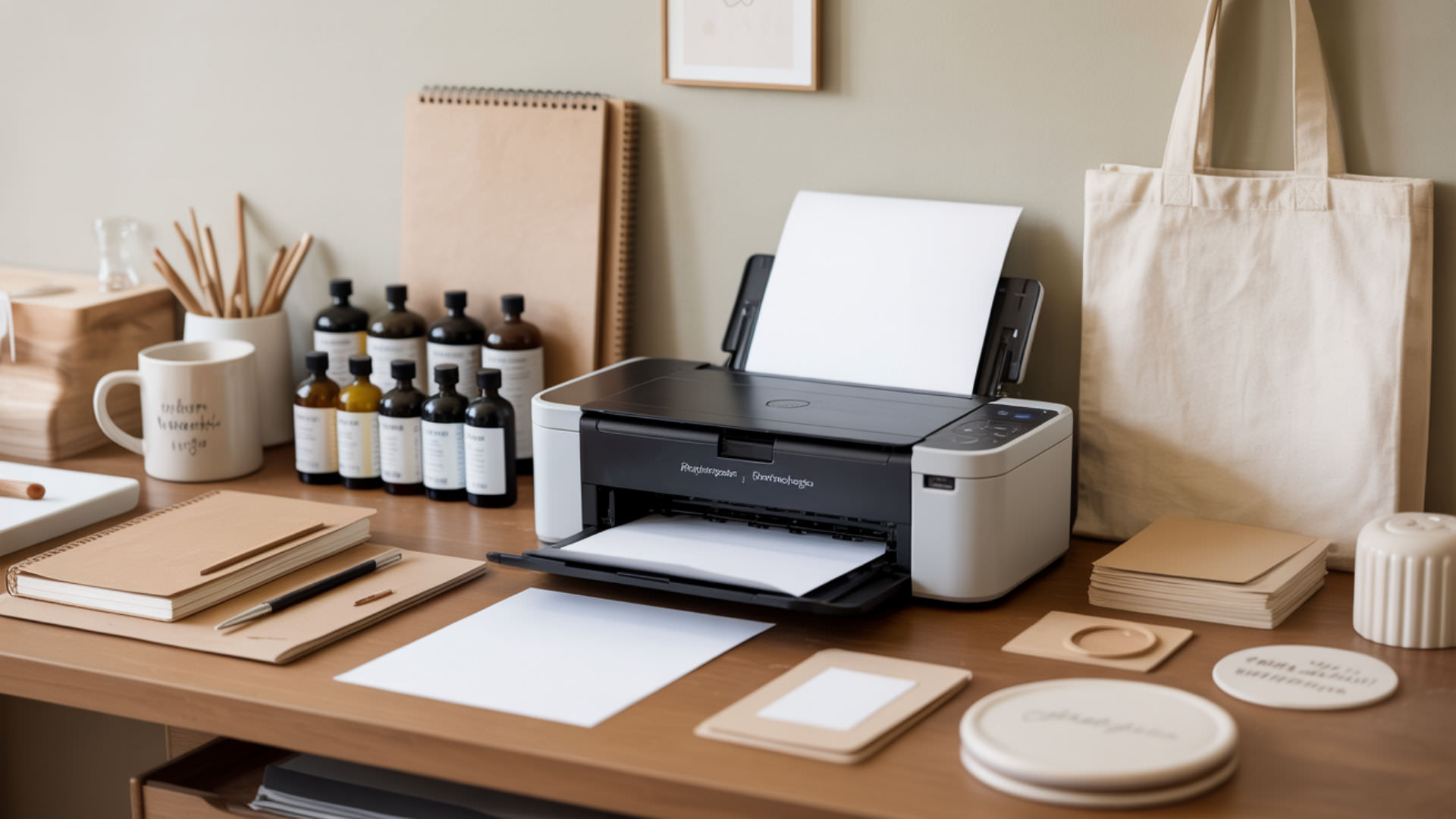Table of Contents
ToggleDye-sublimation ink uses disperse dye chemistry that behaves differently from standard pigment or dye-based inks when cleaning, requiring specific solvents and techniques for safe removal. Ink residue from dried sublimation ink must be dissolved with safe solvents formulated to avoid damaging sensitive print head components and internal ink delivery systems. Because dye-sublimation ink handling and maintenance require specific knowledge, our guide on how to use a sublimation printer provides essential foundational context for this deeper cleaning process.
Key Takeaways
- Ink residue from dried sublimation ink requires specialized cleaning agents rather than water alone for effective removal.
- Cleaning agents designed for sublimation systems dissolve dried ink safely without harming print heads or internal components.
- Regular cleaning prevents severe buildup that becomes increasingly difficult to remove as drying time extends.
Can ink be safely flushed or removed from a sublimation printer?

A syringe flush kit allows controlled flushing of ink from print head channels by pushing cleaning solution through nozzles using gentle manual pressure. The print head is extremely sensitive to physical contact—never scrape, rub, or apply excessive force during ink removal procedures. Power ink flushing utilities built into printer software provide automated flushing that replaces all ink in delivery tubes when manual methods aren’t sufficient. For detailed procedures on restoring proper flow through blocked nozzles, see our guide on how to unclog a sublimation printer.
How do you flush ink from an inkjet printer for sublimation?
Syringe flush kits connect to ink inlet ports on the print head, allowing cleaning solution to be pushed through channels and out the nozzles to clear blockages. Purified water or distilled water prevents mineral deposits that tap water would leave inside delicate print head channels during the flushing process. Fill the syringe with a cleaning solution, attach to the appropriate ink inlet, and apply slow steady pressure—never force fluid through rapidly or aggressively. Distilled water is free of dissolved minerals, which helps prevent residue and scale buildup when cleaning or flushing sensitive equipment. [1]
How do you run a power ink flush safely?
Air bubbles introduced during flushing can lead to ink starvation by creating gaps in ink delivery lines that interrupt continuous flow to the print head. Run a nozzle check immediately after any power flush to confirm all channels are firing correctly and ink flow has been fully restored. Power ink flushing consumes significant ink volume—ensure tanks are at least half full before running the utility, and wait 12 hours before testing print quality.
How do you remove dried ink from a print system?
Solvent cleaning solutions break down dried ink deposits so they can be flushed through nozzles or wiped away from accessible surfaces without damaging components. Cleaning agents formulated specifically for sublimation systems are safe for print heads, seals, and internal plastic parts that harsh solvents would damage. Soak severely clogged print heads in warm cleaning solution for 10–20 minutes to soften dried ink residue before attempting to flush channels.
What solvents work for removing dried or stubborn printer ink?

Isopropyl alcohol (70–99%) effectively dissolves fresh and semi-dried ink on external printer parts, cartridge housings, and non-electronic surfaces where ink spills have occurred. Acetone is too aggressive for sublimation printer use—it dissolves plastics, damages protective coatings, and can destroy seals and gaskets that maintain ink system integrity. For internal cleaning, use only solvents specifically designed for inkjet print heads to avoid permanent damage to sensitive components. Isopropyl alcohol dissolves many organic residues effectively while evaporating quickly, which is why it is commonly used for cleaning sensitive mechanical and electronic components. [2]
What is the safest solvent for dried ink?
Isopropyl alcohol diluted with purified water creates a safe cleaning solution that dissolves dried ink without leaving mineral deposits or damaging print head materials. Mix 50–70% isopropyl alcohol with distilled water for general cleaning; use higher concentrations (90–99%) for stubborn external residue on non-sensitive surfaces. Ammonia-based solutions like diluted Windex can help loosen dried ink, but should be used sparingly and only on external parts.
What solvents dissolve dye-based printer inks effectively?
Solvent cleaning solutions specifically target disperse dye chemistry used in sublimation inks, breaking molecular bonds that water alone cannot affect. Commercial print head cleaning solutions contain surfactants and mild solvents formulated to dissolve dye-based inks safely without attacking plastics or rubber seals. Warm distilled water can loosen fresh deposits, but dedicated cleaning solutions are required for ink that has fully dried and hardened inside channels.
How do you remove printer ink step-by-step from the print system?

The capping station collects ink during automated cleaning cycles—thick buildup on this component must be removed carefully using cotton swabs dampened with cleaning solution. The wiper blade clears ink from the print head edge after each print; accumulated residue causes smearing and must be cleaned regularly with lint-free cloths. Check the waste ink reservoir periodically—overflow from a full reservoir can spread ink throughout the printer interior, requiring extensive cleanup. Maintenance kits typically include wiper blade cleaning tools and supplies needed for this internal cleaning process—see our best sublimation printer maintenance kit guide.
Can common liquids dissolve or remove printer ink without damage?

Tap water and hard water contain minerals that encourage scaling and calcium buildup inside print head channels, making clogs worse over time rather than better. Deionized water or distilled water is the safer option for sensitive internal cleaning because it leaves no mineral residue that could accumulate and block nozzles. Never use tap water for flushing print heads—mineral deposits from a single flush can create permanent blockages in channels as small as 20–50 microns.
Does isopropyl alcohol dissolve printer ink?
Isopropyl alcohol effectively dissolves fresh and semi-dried ink residue on external parts, cartridge contacts, and printer housings where spills have occurred. Lint-free cloths or cotton swabs soaked with isopropyl alcohol remove dried ink and debris without scratching delicate surfaces or leaving fibers behind. For internal print head cleaning, dilute isopropyl alcohol with distilled water to reduce solvent strength and protect sensitive components from chemical damage.
Can vinegar help remove printer ink in some cases?
Vinegar’s mild acidity can help loosen ink residue on external surfaces, but it is not recommended for internal printer cleaning due to potential corrosion of metal components. Cleaning agents specifically formulated for printers provide safer, more effective results than household alternatives like vinegar or dish soap. For external ink spills on hands or work surfaces, vinegar mixed with water can help lift fresh ink stains before they fully set.
Can sublimation ink be removed from fabrics if pressed incorrectly?

Dye-sublimation ink uses disperse dye that bonds permanently inside polyester fibers under heat, making true removal extremely difficult once the transfer process has completed. The heat-activated gasification causes dye molecules to penetrate the polymer structure of polyester fabric at the molecular level, creating a bond that becomes part of the fiber itself. Incorrect colors or misprints often lead to ruined transfers—for deeper information on preventing ink and color issues that cause mispressed garments, see our guide on dye-sublimation ink color problems.
Is there a way to remove sublimation ink from a shirt safely?
Heat can re-activate disperse dye and allow partial lifting from polyester fabric, but this technique typically achieves only 30–70% fading rather than complete removal. Rubbing alcohol applied to the stained area and blotted with a clean cloth may lift some ink, though results vary significantly based on how long the transfer has cured. Commercial sublimation ink removers can fade prints without destroying polyester fibers, but complete removal of heat-set sublimation ink is rarely achievable.
Can sublimation ink stains be removed from polyester fabric?
Disperse dye penetrates polyester fibers at the molecular level during heat pressing, creating a permanent bond that true removal methods cannot fully reverse. The sublimation process transforms ink into gas that infuses into the polymer structure—this is intentionally permanent and designed to resist washing, fading, and wear. Accept that sublimation prints on polyester are meant to be permanent; prevention through accurate printing and pressing is far more effective than attempting removal.
What techniques remove sublimation ink from hard surfaces?

Solvent cleaning is more effective on non-porous hard surfaces than on fabrics because ink films sit on top of coatings rather than penetrating into fiber structures. Dust mixed with wet ink creates sludge that must be fully removed before it dries into a hardite residue that’s much more difficult to dissolve and clean. Work quickly on fresh spills—acetone can remove sublimation ink from hard surfaces but may damage plastic or painted components if contact is prolonged.
Can ink be lifted using controlled heat?
Heat re-mobilizes disperse dye on some rigid substrates like tumblers and ceramic tiles, allowing partial removal by transferring activated ink onto sacrificial fabric or paper. A heat gun held 1/4 inch from the surface with constant movement can soften ink for removal, though technique requires practice to avoid overheating and damaging substrate coatings. Check progress every 15 minutes when using heat removal methods, and rotate items to ensure even heating across all surfaces.
What works for removing sublimation ink from metal drinkware?
Solvent cleaning with acetone or rubbing alcohol can soften and lift ink films from coated metal tumblers when applied carefully and worked with a soft cloth. Ink residue on polymer-coated drinkware responds to heat reactivation—apply heat with a heat gun while pressing clean fabric against the surface to absorb mobilized dye. For small spots or mistakes, targeted heat application followed by immediate wiping often produces better results than chemical solvents alone.
Ready to Remove Ink From Your Sublimation Printer?
Ink residue removal requires patience, proper solvents, and gentle technique to avoid damaging sensitive print head components during the cleaning process. Cleaning agents specifically designed for sublimation systems provide the safest, most effective approach to dissolving dried ink without harming printers. Regular maintenance cleaning prevents severe buildup that requires aggressive intervention—weekly wipe-downs and monthly deep cleaning keep ink removal simple and quick.
Frequently Asked Questions
Can sublimation ink clog faster than standard dye ink?
Sublimation ink uses disperse dye that dries and thickens more rapidly than standard dye inks, with deposits beginning to form within 5–7 days of idle time. The specialized dye chemistry that enables gasification during heat transfer also makes sublimation ink more prone to hardening inside print head nozzles when left stagnant. Print weekly test patterns to keep ink flowing and prevent the accelerated drying that sublimation systems experience compared to standard inkjet printers.
Does deep ink flushing shorten printer lifespan?
Repeated deep flushing cycles can affect print head longevity because the process stresses components and accelerates wear on seals, wiper blades, and pump mechanisms. Power ink flushing should be reserved for severe clogs that standard head cleaning cannot resolve—running it unnecessarily wastes ink and adds wear to the system. Limit deep flushing to 2–3 times per year maximum, and focus on preventive maintenance to avoid situations requiring aggressive cleaning.
Can sublimation ink fade if the system is not flushed fully?
Incomplete flushing can leave old ink residue in delivery lines that mixes with fresh ink, potentially causing inconsistent color output or contamination issues. Air bubbles trapped during partial flushing create gaps in ink flow that produce banding, faded colors, or complete channel failure in affected nozzles. After any flushing procedure, run multiple nozzle checks and test prints to confirm complete ink flow restoration before returning to production work.
What are early signs of ink drying in a printer system?
Ink starvation symptoms appear first as faint or missing lines in nozzle check patterns, indicating partial clogs are forming before complete blockage occurs. Print quality degradation including banding, color shifts, or reduced vibrancy often signals that ink is beginning to dry and restrict flow through channels. Catching early warning signs allows simple head cleaning to resolve issues before dried ink requires aggressive flushing or manual intervention.
Can flushed printers be reused for sublimation transfers afterward?
Printers properly flushed and refilled with fresh sublimation ink can return to normal production printing once ink flow is fully restored and verified through nozzle checks. Re-prime ink lines after flushing by running 2–3 cleaning cycles followed by test prints to ensure complete color saturation has been restored across all channels. Allow 12–24 hours after major flushing procedures before evaluating final print quality, as ink needs time to fully saturate delivery systems.
References
- (n.d.). Purdue Extension. https://www.extension.purdue.edu/extmedia/HO/HO-216.pdf
- Isopropyl alcohol. (n.d.). Centers for Disease Control and Prevention | CDC. https://www.cdc.gov/niosh/npg/npgd0359.html














